The Tampa Bay Rays were eliminated from playoff contention on October 1st, falling short of their fourth playoff appearance in five seasons, but it wasn’t because of their pitching. The staff’s walk rate fell from 3.1 per nine innings in 2011 to 2.9 in 2012, and its strikeout rate rose from 7.1 strikeouts per inning to 8.5, good enough to set a single-season AL strikeout record. Granted, it wasn’t exactly the same group of pitchers in both seasons, and the strikeout rate rose across the league. But the pitching improvement wasn’t just maturation on the part of the pitchers or another manifestation of the game’s trend toward more strikeouts. There was also a Molina in the machine.
In March, I mentioned the Rays’ Jose Molina signing as one of my favorite moves of the offseason, writing “Molina for $1.5 million (plus an option for 2013 at the same price) might be the best value any team got from the free agent market this winter.” The month before, Max Marchi had summarized Molina’s weaknesses (hitting and blocking) and strengths (framing and throwing) in a piece called “What Are the Rays Expecting from Jose Molina?” Like Mike Fast, Max found that Molina was among the best backstops in baseball at the things he was good at and among the worst where he struggled. But according to Max’s calculations, Molina’s framing skill was so superlative that it made him the best pitch-for-pitch defensive catcher of the past 60 years, which more than made up for his flimsy bat. That’s why the Rays wanted him, and that’s why it looked like they’d gotten a good deal.
Despite his considerable contributions behind the plate, Molina had a PR problem: the damage his bat was doing was easier to see than his subtle skills behind the plate, especially when he started the season with a .186/.255/.256 slash line in April. Rays fans could see the improvements in the team’s pitching, and his pitchers appreciated his efforts, but the statistical gains showed up in other players’ stats. Every now and then, Molina would make a cameo appearance on SportsCenter, but he usually played a supporting role in someone else’s helmet slam: Cody Ross’ in mid-April, Brett Lawrie’s in mid-May. The framed pitches that touched off those tantrums were forgotten in the furor that followed.
To their credit, the Rays, who knew what they had, kept running (or rolling) him out there, giving him the most starts, innings, and plate appearances at catcher that he’d had in any season except 2008. To his credit, Molina didn’t break down. But he also didn’t take center stage** (on Twitter, anyway) until after the Rays had been bounced, when Max tweeted this:
Just run my codes for catchers rating. The final number on Jose Molina's framing is 50 runs saved!
— Max Marchi (@MarchiMax) October 5, 2012
Later that day, Rays manager Joe Maddon went on 620 WDAE-AM in Tampa with co-hosts Ron Diaz and Ian Beckles, and he and Beckles had this exchange:
Beckles: Hey Joe, a lot of the moves you make throughout the season are going to be questioned, and it doesn’t matter to you—most of them work out. The one, I guess, move that gets questioned more than any others is Jose Molina, as much as he played this year. Explain to us what Jose Molina has, or what he offers, that either [Chris] Gimenez or [Jose] Lobaton doesn’t offer.
Maddon: Well, I could reveal to you a stat that I just got today that I think would really blow some people’s minds up. I don’t know exactly how it’s calculated or formulated, but it was concluded that he saved us 50 runs this year. And that’s highly significant. You could break down—you know, people just notice once well, maybe he does not block a baseball. I agree with that, although when he has to, he has blocked the ball well. Early in the season, he was not throwing well, but by the end of the year, he was one of the best throwers in the American League. Also by the end of the year, he started hitting the ball and impacting it a lot better. But we did not—whatever we get from his bat was always going to be a bonus. It was primarily based on defense. So if you get a catcher that’s saving you 50 runs on an annual basis, that is highly significant. So, again, without—I don’t have all the information in front of me, but that’s a highly significant number. So, at the end of the day, people are going to look at the superficial part of all this, but we can’t do that. We do have to look under the hood, and actually, Jose was very, very prominent in our success this year.
We don’t know for sure whether Maddon was referring to Max’s calculations. The timing certainly suggests that he was, but maybe there’s another explanation–after all, October 5th was two days after the season ended, which is about when Maddon might have received the Rays’ internal end-of-season reports. Maybe Max’ numbers matched up with the Rays’ own evaluations exactly, or closely enough that they felt there was no harm in letting the stat slip when someone else had already put it out there.
Wherever Maddon's stat came from, it's impossible to pinpoint his motivations for repeating it on air. We never really know why teams say what they say. Maddon might not actually believe the 50-run rating. Maybe he just wanted to make Molina feel good, pump up his trade value, or make his pitchers more confident in their batterymate. Maybe he wanted to justify his decision to use Molina as much as he had. Maybe framing is all an illusion and the Rays just wanted to pull the wool farther over everyone else's eyes (I don't think it's that one).
But imagine what it would mean for Molina’s value if his framing really was worth 50 runs. Without factoring in blocking, throwing, or framing, Molina was worth 0.2 WARP. The defensive systems agree that Molina’s good throwing added roughly as many runs as his poor blocking subtracted, so let’s call those a wash. Add 50 runs, or five wins, to his tally, and his total rises to 5.2, which would make him the most valuable Ray and tie him with Adam Jones and Giancarlo Stanton at 12th overall. Only 15 players had at least 5.0 WARP this season, so we’re talking about Jose Molina—chunky, 37-year-old Jose Molina, who started 80 games, made less than half as much money as sub-replacement player Juan Rivera, failed to hit his weight, and made two Tampa Bay radio hosts wonder what he had that Chris Gimenez and Jose Lobaton didn’t—being one of the best 15 players in baseball.
It does only so much good to spew stats about Molina’s special season. This is one of those times when “show” works better than “tell,” so here’s a list of the 10 pitches farthest away from the center of the strike zone (in any direction) that were called strikes with Molina catching.*
10.
Date, Matchup, Inning, Outs, Count: May 11th, Jeremy Hellickson vs. Matt Wieters, seventh, zero, 1-0
Distance from center of strike zone: 1.44 feet, low
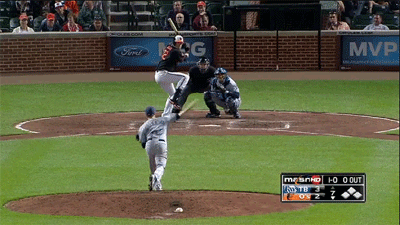
Batter reaction: None, but one guy in the stands booed very loudly, and the Orioles’ announcers were upset. “One thing about Matt,” an upset Orioles announcer said, “he may not agree, but you will never, ever see something like that affect him.” This is totally true: Wieters has only ever been ejected once, and it was while he was behind the plate, not in the batter's box.
9.
Date, Matchup, Inning, Outs, Count: May 4th, Brandon Gomes vs. Seth Smith, ninth, two, 0-0
Distance from center of strike zone: 1.45 feet, outside
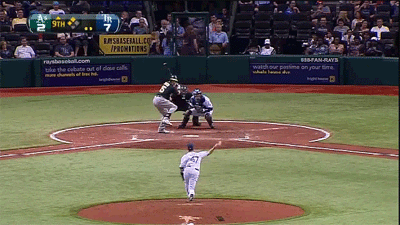
Batter reaction: "Really?"
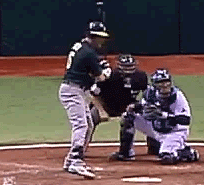
8.
Date, Matchup, Inning, Outs, Count: June 14th, Jeremy Hellickson vs. David Wright, fourth, two, 2-1
Distance from center of strike zone: 1.45 feet, low and inside
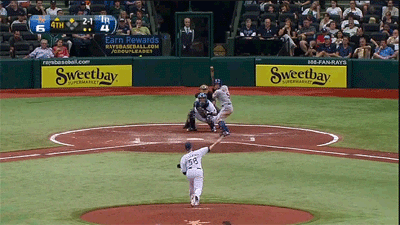
7.
Date, Matchup, Inning, Outs, Count: September 8th, Chris Archer vs. Geovany Soto, fifth, one, 0-0
Distance from center of strike zone: 1.47 feet, high and inside
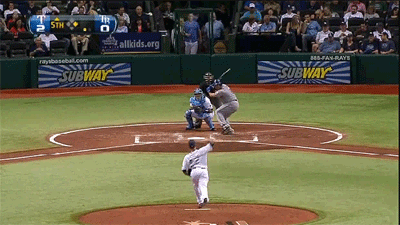
So far, we've seen four called strikes: one low, one outside, one inside, and one high. Molina can frame pitches pretty much anywhere.
6.
Date, Matchup, Inning, Outs, Count: July 3rd, James Shields vs. Alex Rodriguez, first, zero, 1-2
Distance from center of strike zone: 1.48 feet, low and inside
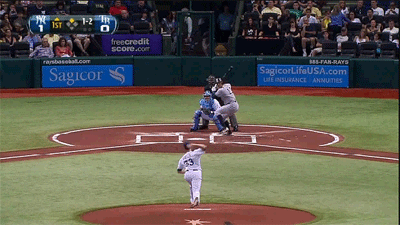
Sometimes, when Molina is really feeling a frame, he'll freeze time and squat perfectly still for seconds while the pitcher, batter, umpire, and fans all continue their movements around him. Eventually the umpire takes the hint and calls the strike, and Molina rejoins the rest of the universe.
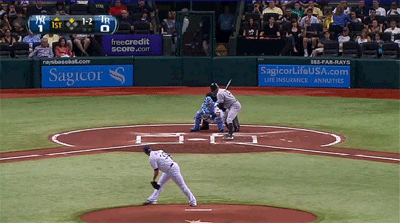
Batter reaction: Denial. Maybe if I just keep rearranging this chalk with my foot, the frame will turn out not to have happened.
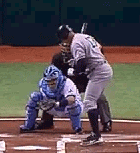
Terrible attempt at lip-reading: "Ha! I messed up the batter’s box."
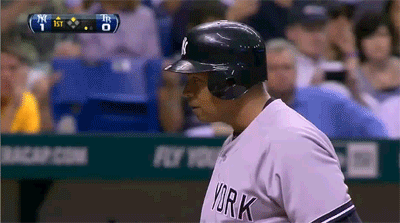
5.
Date, Matchup, Inning, Outs, Count: September 19th, Chris Archer vs. Daniel Nava, fourth, two, 3-0
Distance from center of strike zone: 1.48 feet, high and outside
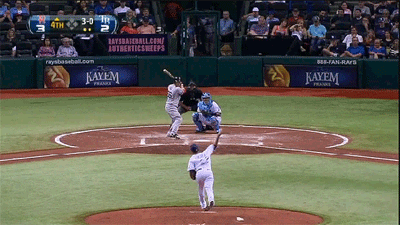
4.
Date, Matchup, Inning, Outs, Count: April 26th, Burke Badenhop vs. Alberto Callaspo, sixth, two, 0-0
Distance from center of strike zone: 1.48 feet, high and outside
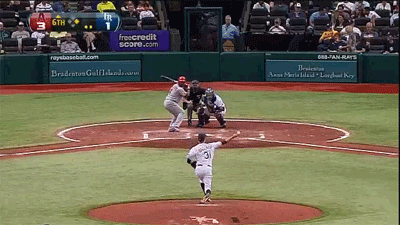
Batter reaction: Clay Davis.
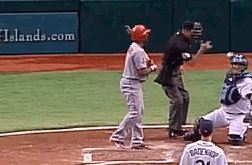
3.
Date, Matchup, Inning, Outs, Count: April 8th, Jeremy Hellickson vs. Raul Ibanez, seventh, zero, 0-0
Distance from center of strike zone: 1.49 feet, low and inside
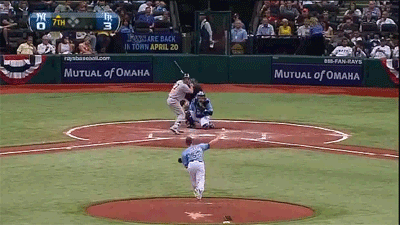
2.
Date, Matchup, Inning, Outs, Count: September 8th, Chris Archer vs. Adrian Beltre, second, zero, 0-0
Distance from center of strike zone: 1.57 feet, low and inside
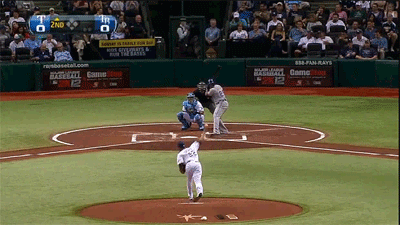
Batter reaction: Peaceful protest.

1.
Date, Matchup, Inning, Outs, Count: May 18th, James Shields vs. Dan Uggla, third, two, 2-2
Distance from center of strike zone: 1.59 feet, low and inside
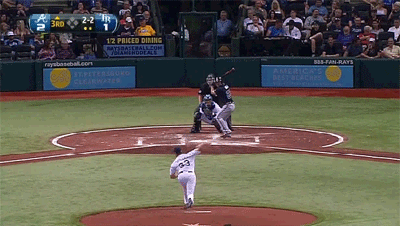
This video was captured at 20 frames per second, and the video (or series of stills) below is five frames, so this whole thing comprises a quarter of a second. In the first 20th of a second after catching the pitch, Molina moves the glove horizontally toward the center of the zone. In the second 20th of a second, he moves it vertically toward the center of the zone. Less than a second later, he gets James Shields a strikeout.***
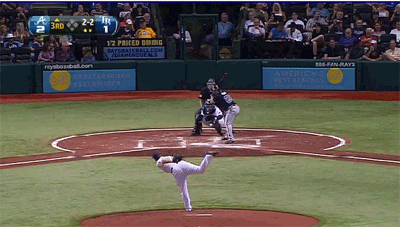
Batter reaction: Stands at attention to pay proper respect to the frame.
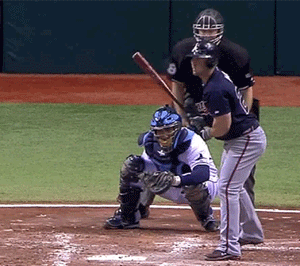
Followed by: ​Mutual frowny face.
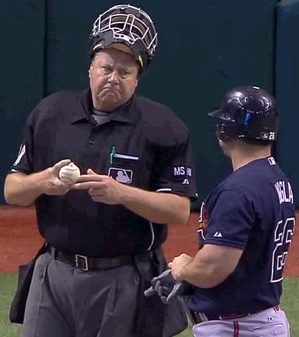
In case you were wondering: yes, the Rays picked up Molina's option for 2013.
*These 10 pitches with the greatest total distance away from the center of the zone aren’t the same as the pitches with the lowest probability of being called strikes. The pitcher, the pitch type, the batter, the count, and the umpire all influence the probability that a pitch will be called a strike, but we don’t currently have strike probability calculated on a pitch-by-pitch basis, and those factors wouldn’t come across very well in a GIF. It also would have been possible to look up the called strikes that were farthest away from the nearest edge of the strike zone, which would have yielded different (and possibly even more eye-popping) results.
**Molina's defense did win him one actual honor, apart from Max' tweet, Maddon's comment, and this article: he was named the inaugural Rays recipient of the Wilson Defensive Player of the Year Award, which seems to be something the Wilson company cooked up after belatedly realizing that Rawlings has been sponsoring the Gold Gloves for the last 55 years.
***As Max pointed out when I showed him this GIF, Molina's commitment to framing might actually be a cause of his poor blocking performance. Another catcher might have given up on getting that pitch called a strike and gone into "block mode" early, which would likely lead to fewer passed balls but also fewer frames. If a few more passed balls is the price of Molina's framing performance, it's a price well worth paying.
Thanks to Ryan Lind, Max Marchi, and Colin Wyers for research assistance.
Thank you for reading
This is a free article. If you enjoyed it, consider subscribing to Baseball Prospectus. Subscriptions support ongoing public baseball research and analysis in an increasingly proprietary environment.
Subscribe now
I don't have the data past 2010, but have most of this put together at a general level using my semi-parametric models I have talked about before (pitch type, count, location, right/left handed batter/pitcher, pitcher fixed effects) if you guys are interested. Easy to go through 2012 if someone has the data easily accessible and is willing to share.
You could do a more detailed analysis and figure out the linear weight for converting one ball into one strike on a frequency-averaged count, but the super-rough figure of "stealing" one strikeout per 10 IP doesn't seem intuitively out of line.
As another example, if you plot all regular American League home-plate umpires by K/9, they ranged from 8.9 (Dan Iassogna) to 6.2 (Sam Holbrook) in 2012. K/BB ranged from 1.88-3.58, almost a factor of 2. There's already huge variation in umpire tendencies, and it's not unreasonable that a Crafty Molina could sway a malleable umpire by ~0.8 K/9, when umpires vary from each other by 3x that.
Using the higher value, he'd need to switch a ball to a strike 312 times, or once every 2.25 innings.
That feels high to me, and this is a substantially bigger effect than we've seen before, but Max's approach is pretty solid.
Also, in some of the breaking balls GIF'ed here, it is possible that the pitch crossed the zone and then was caught at a position far from the center of the zone. If that is the case, the pitch would have accurately been called a strike, and Molina would not have saved anything.
That said, a number of those pitches were not benders and Jose's Molina-like hands certainly manipulated the ump.
o) 50 runs saved is actually above the average MLB catcher, so the 5.0 calculation is 5 wins above average. The WAR would presumably be materially higher - an extraordinary number given the number of innings Molina caught, in fact it's suddenly Mike Trout-like when normalized over 162 games.
o) Normalized over a full season, 100 runs saved comes to about 0.62 runs per 9 innings. Could a catcher lower the staff's ERA by 0.62 through pitch framing? It's possible and as some comments above show, a weighting of walks and strike outs might reveal that but . . . . .
o) For a rough test, let's just look at the CERAs of the entire Rays catching staff. Jimenez: 3.21, Lobaton: 3.24, and Molina: 3.22. They're identical! (A look at CRA reveals the same thing.)
It just doesn't pass the smell test that without Molina's run-saving abilities compared to an average catcher, the Rays' pitchers would have suddenly had ERAs around 3.8 but yet still had 3.2 ERAs with Jimenez and Lobaton behind the plate.
I don't know how to calculate it, obviously, but it seems impossible Molina could have added so much value compared to the other catchers and yet they all allowed the same amount of runs to score with the same staff, in the same ballparks, with the same defense, and against the same hitters.
I'm open to having holes 1.59 feet in diameter poked in my logic.
The pitch framing studies have been excellent and rigorous, as far as I've been able to tell, but this will certainly need further explanation before we can say we have some confidence that we know how catcher defense helps win games...
In 2011, Molina had a 4.38 CERA/4.65 CRA, and Arencibia had a 4.30/4.71. Essentially identical.
In 2010, Molina had a 3.72/4.01, Buck had 4.45/4.78, and Arencibia had 4.43/4.86. Big advantage for Molina.
In 2009, Molina had 3.31/3.79, Posada had 5.02/5.50, and Cervelli had 3.43/3.52. Big advantage over Posada, not so much Cervelli.
In 2008, Molina had 3.70/3.97, Posada had 4.61/5.03, Rodriguez had 5.59/5.87, Moeller had 4.20/4.28. Big advantage for Molina again.
Overall Molina seems to have had a CERA/CRA advantage over other catchers, but not in recent years. Didn't check for "personal catcher" effects though, which make a BIG difference.
To the point about replacement level, the way a replacement level metric is constructed, you don't need to measure the individual components relative to replacement, you measure components relative to average and figure in replacement level as an additional step. So you don't need to do anything to Molina's runs saved relative to average to include it in a replacement level metric.
I agree fifty runs is a lot of runs. I'll be getting into this more deeply soon, as I'm working on adding catcher runs saved to the sortables and WARP (based on Mike's work), and once we have that ready I'll have a lot more to say on the subject.
(or maybe good framing catchers get the "rulebook" strikezone called more accurately? -- i.e. get high and low strikes that typically are called "balls" called correctly instead?)
(come to think of it, do catchers have "personal strike zones," like umpires? Like do certain catchers get, say, more outside pitches to left-handed hitters called strikes than the composite career tendency of their umpires would predict? Sample-size might be an issue, but I'd think someone who's been around for a million years like Molina might show some distinct tendency)
http://www.insidethebook.com/ee/index.php/site/comments/jose_molina_pitch_framer/#5